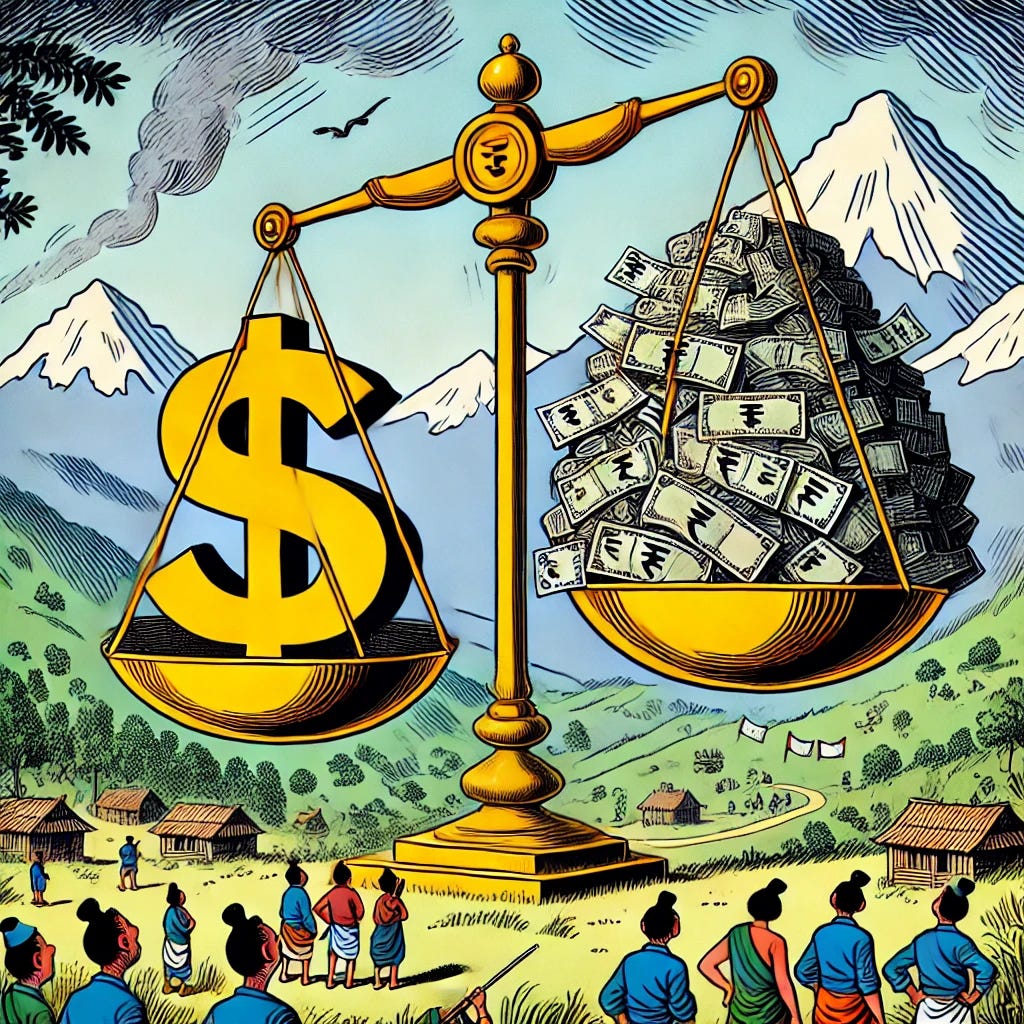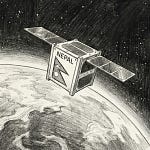📢 Our Ask This Week! If you enjoy this digest, share the love! 💙 Forward it to friends, family, or colleagues who’d love to stay updated on Nepal. Your support means the world! 🙌✨
Welcome to another whirlwind week in Nepal, where the rupee is on a losing streak, the internet had a dramatic ‘power nap,’ and politicians are still stuck in an endless tug-of-war over ordinances. Meanwhile, wildfires are making an early and unwelcome entrance, and the government is promising 5G even while 4G still struggles to load memes. But it’s not all doom and gloom—search-and-rescue tech is getting an upgrade, local pharma is stepping up, and Everest climbers might finally have to make some friends now that solo expeditions are off the table. Buckle up, because there’s a lot to unpack!
Economy & Development 💸
Nepal’s economy is facing mounting pressure as the Nepali rupee continues to weaken against the US dollar, hitting a record low of Rs. 141 per dollar (Republica). The fall is mainly due to the weakening Indian rupee, to which Nepal’s currency is pegged, and the relentless strengthening of the US dollar. As India grapples with trade deficits and declining foreign reserves, the ripple effect is felt in Nepal, where the cost of imported goods is rising sharply. The US dollar’s rise has been fueled by higher interest rates, strong economic data, and global investors seeking safe-haven assets, making it even more expensive for Nepal to settle foreign debts and purchase essential imports.
With Nepal heavily reliant on imports for fuel, food, medicine, and raw materials, a weaker rupee means higher prices and increasing inflation, which stood at 5.41% in January (Kathmandu Post). This is making everyday essentials more expensive for Nepali households. Businesses, too, are feeling the impact as rising import costs drive up production expenses, potentially slowing investment and economic activity. Additionally, the government now faces higher repayment costs on foreign loans, further straining national finances.
However, not all effects are negative. The remittance sector, which plays a crucial role in Nepal’s economy, is benefiting as Nepalis working abroad send home higher-value foreign earnings, providing relief to many families. Exports, particularly in handicrafts, textiles, and tea, could also gain a competitive edge as Nepali goods become cheaper in international markets. Still, since Nepal imports much more than it exports, the benefits may not be enough to offset the broader economic challenges. Experts are calling for stronger policy measures, including boosting domestic production, managing inflation, and strengthening foreign reserves, to help stabilize the economy in the months ahead.
Other Developments in Economy and Healthcare
In the healthcare sector, Nepal Aushadhi Limited, the government-run pharmaceutical company, has taken a major step by securing a Good Manufacturing Practice (GMP) certificate, meeting WHO standards (Rising Nepal). With government funding of Rs. 247.8 million, the company aims to produce 98 essential medicines locally, reducing dependency on imports and making vital drugs more affordable.
Meanwhile, Nepal has introduced new search-and-rescue technology in the Himalayas with the RECCO SAR Helicopter Detector system (Himalayan Times). Now operational with trained Nepali pilots and mountaineers, the system allows faster aerial searches, improving safety for trekkers and climbers in the region.
Social & Cultural ⭐
Nepal recently experienced a nationwide internet outage, leaving millions without service and exposing the country’s heavy reliance on Indian bandwidth providers. The disruption, which began at 8 p.m. on Sunday, was linked to unpaid dues of over NPR 600 million to Airtel, the primary provider for Nepal’s ISPs. As a result, major internet services, including WorldLink, CG, and Vianet, slowed to a crawl, forcing many users to turn to mobile data. Frustrated netizens flooded social media with complaints, humor, and memes, with some even jokingly tying the outage to the controversial "troll bill" in Parliament. This isn’t the first time Nepal has faced such issues—last May, a similar outage occurred due to financial disputes, raising concerns about the country’s digital vulnerability. With Airtel supplying 80% of Nepal’s bandwidth and only limited alternatives from Tata Communications and China, experts warn that without better financial and infrastructure planning, future outages are inevitable. THT, OnlineKhabar
Meanwhile, wildfires in the Gaurishankar Conservation Area are raging out of control, turning snow-capped peaks black with smoke and threatening wildlife such as red pandas and Himalayan tahrs. The fires, which started unusually early in the season, have been worsened by a lack of snowfall, leaving forests dry and highly flammable. Conservation authorities suspect human negligence, with reports indicating that abandoned cooking fires and carelessly discarded embers may have been the cause. Firefighters and local teams have struggled to contain the blazes due to the steep and rugged terrain, forcing some efforts to be abandoned. At the same time, fire incidents are also rising in Kathmandu, with officials warning that the dry season could lead to even more outbreaks if proper precautions aren’t taken. The increasing frequency of wildfires has raised concerns about climate change and the need for better fire prevention measures in Nepal’s vulnerable regions. KTM Post, THT
In other news, Nepal has banned solo expeditions on Everest, citing safety concerns, and the government is taking steps to recognize intangible cultural heritage for the first time. Efforts are also underway to enlist the Budhanilakantha Temple as a UNESCO World Heritage site. Additionally, tenant farmers from Dang have launched protests in Kathmandu, demanding land rights after decades of cultivating trust-owned land. These developments reflect the evolving social and cultural landscape of Nepal. KTM Post, Nepal News, TRN
Politics & Governance 🪧
Nepal’s political landscape remains tense as Prime Minister KP Oli convened a high-level coalition meeting to break the deadlock over six key ordinances. The government had planned to table them in Parliament but withdrew at the last moment due to a lack of majority in the National Assembly. The fate of these ordinances now hinges on the Janata Samajbadi Party-Nepal (JSP-Nepal), whose three votes could tip the balance. JSP-Nepal has voiced strong reservations, questioning the urgency behind the move. Meanwhile, public frustration is growing over Parliament’s sluggish pace, with critics blaming absentee lawmakers and a lack of political will for the delays in legislation. As debates continue, Oli has defended the ordinances as necessary due to the slow pace of lawmaking, but opposition leaders argue they undermine democratic procedures. With over 50 motions filed against the ordinances, Nepal’s legislative deadlock shows no signs of easing. Read more on KTM Post.
Outside the political sphere, Nepal’s slow digital infrastructure growth has prompted Communications Minister Prithvi Subba Gurung to vow the establishment of an IT Park in Kathmandu within the year, aligning with the Digital Nepal Framework. The government also plans to expand 4G services to all 753 local levels and introduce 5G in Kathmandu Valley soon. However, past promises of digital expansion have often stalled due to bureaucratic inefficiencies and financial constraints. Netizens have expressed mixed reactions—some welcome the initiative, while others question the lack of urgency in tackling frequent internet outages, especially in rural areas. Online discussions highlight growing skepticism, with users pointing out past failed commitments to improving connectivity. Full story on TRN.
Meanwhile, diplomatic concerns have taken center stage as the Nepali government urged Israel to intensify efforts for the release of Bipin Joshi, a Nepali student held captive by Hamas, while aviation safety is once again in the spotlight. Long-delayed civil aviation bills have returned to Parliament, aiming to separate Nepal’s aviation regulator from its service provider—a key step toward lifting the EU airspace ban on Nepali airlines. These bills, stuck in legislative limbo for over a decade, are essential for improving air safety and international compliance. Aviation experts warn that further delays could hurt Nepal’s global aviation standing, and with European authorities closely monitoring the situation, pressure is mounting for swift action. More on THT.
Did you know ❓
The Kathmandu Valley’s famous Ason Bazaar is over 1,000 years old! 🛍️ This bustling market has existed since at least the Lichhavi period (400–750 CE) and has been a major trade hub connecting Tibet and India for centuries. Even today, Ason remains one of Nepal’s most important commercial centers.
Diaspora
Nepal received Rs 763 billion in remittances in just six months of the current fiscal year, marking a 4.1% increase from last year. While still growing, the pace has slowed compared to the 22.2% surge recorded in the same period last year. Meanwhile, the number of Nepalis heading abroad for work continues to rise—over 230,000 received first-time approvals for foreign employment, an 11.7% increase, while 162,000 renewed their permits, up 21.4%. Despite steady inflows, experts warn that over-reliance on remittances makes Nepal vulnerable to external economic shocks, emphasizing the need for stronger domestic job creation. More on THT.
Let’s connect
What do you think? Share your thoughts or suggest topics for next week—let’s keep the conversation going! Feedback form | Facebook | LinkedIn
About Nepali Diaspora Digest:
The Nepali Diaspora Digest connects the global Nepali community with curated news, insights, and stories that matter most. Join us as we celebrate and explore the diverse voices and achievements of Nepalis worldwide.
Partner shout out
belayat.uk: helping Nepalis connect in the UK on jobs, housing, events and finding local nepali owned businesses

















